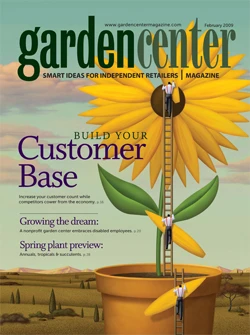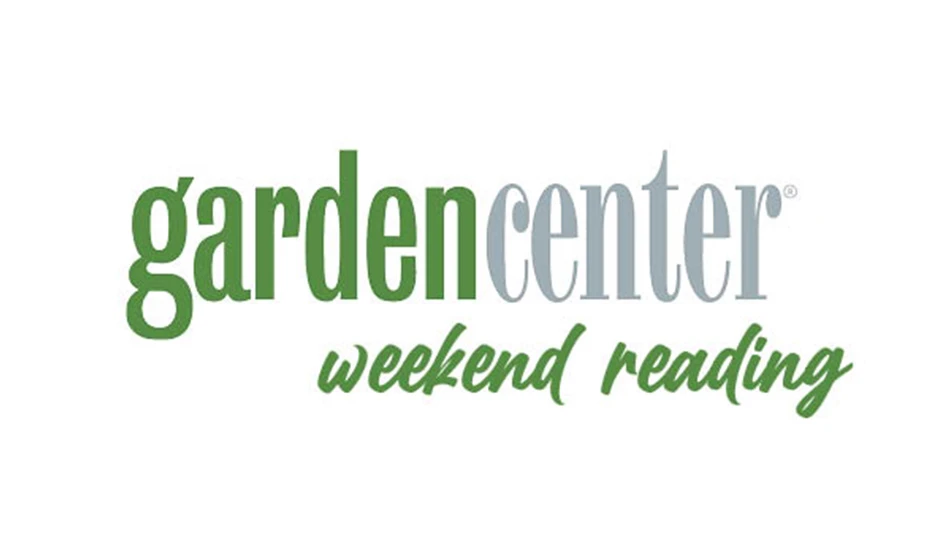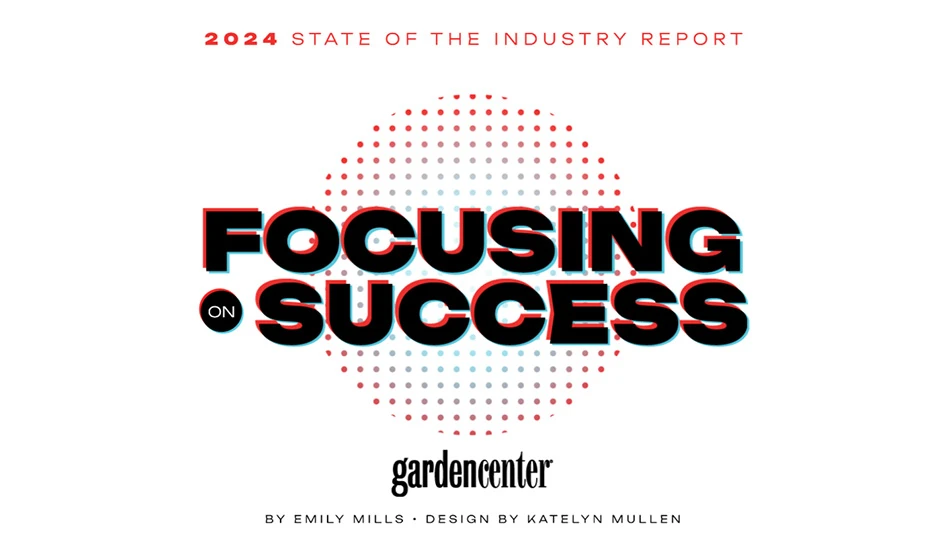
If you keep your head, it’s a perfect time to increase your market share. The past few years, many garden centers have had higher sales per customer, yet a lower customer count With even big boxes in panic mode, you have a rare opportunity to significantly build your customer base.
Maintain your advertising
Many garden centers are tempted to cut back on their advertising during lean times.
If you cut back, you’re giving your competition the edge. Savvy retailers find ways to increase—or at least restructure—their advertising budgets during tough times.
“Maintaining your level of advertising is 180 degrees from your knee-jerk reaction,” said Robbie Brown, president of R. L. Brown & Associates in Chicago. “You may need to cut your advertising, but you don’t want to do it with a machete; you want to do it with a scalpel.”
Becky Hookanson, president of Planet Management in Boulder, Colo., agreed. “Consumers are reading the newspaper and looking hard at e-mail specials to see where the deals are,” she said. “If you’re not in the mix, your company will get lost.”
One thing you may want to do is reallocate dollars from one form of advertising to another. For example, if you’ve been running billboards, you’ve been engaging in passive advertising.
“That’s image-building advertising, and in tough times it’s not going to do much for you,” Brown said. “You need to go to more aggressive advertising that’s price and value oriented. So you might move from billboards and Yellow Pages advertising toward internet and newspapers, which is more aggressive.”
Still need to trim costs? “I’m a big believer in e-blasts and post cards,” Hookanson said. “They’re inexpensive and can have an impact.”
Vie for vendor partnerships
When times are tough, you need to be more creative about the advertising and promotions you undertake.
You can look to your vendors for help.
“Look at different categories and see if some of your suppliers are willing to help promote those categories,” Hookanson said. “Suppliers want their goods sold too; they have some ‘skin’ in the game.”
Brown agreed. “First, recognize that you’re not standing in the bathtub alone,” Brown said. “So think in terms of partnerships with your key vendors, where you both share the cost, the ideas, the tools you need and the benefits.”
By the same token, if you mark down products to move them, Brown said, there’s no reason for you to pick up the total cost of that markdown.
“You should be able to share that with the vendor,” he said. “When you begin to work with a vendor, you buy products for promotion. The vendor can either work up an item, or make a price concession for you. Now you’re working together.”
Say you’re talking about barbeque tools. The vendor may bring in someone to do a barbeque, demonstrate how the tools work and serve up samples.
“How-to seminars are great, too,” Brown said. “The big box stores are really good at that.” You should be too.
| Offer no-ouch “bargains” Hookanson’s suggestions: Most consumers won’t blink an eye at 10- to 15-percent off, but they’ll come in for 25- to 30-percent off. You also can offer free shipping or delivery. Another strategy is buy one get one 50-percent off, or buy two, get one free. I would suggest you start a marketing promotion file, with e-mails and what you see in flyers that come to your home or business. If they look good to you, they’ll look good to your customers. The balance is giving a perceived good deal but not appearing desperate. Brown’s ideas: Suppose you have 250 visitors on a Saturday, and 200 make a purchase. If you say, ‘Here’s a gift from us to you,’ and put a $5 bounce-back coupon in the bag, you’d be surprised at the number of people who either come right back into the store and make an additional purchase, or come back the next weekend and make a purchase. That costs you next to nothing, but increases your incremental sales. Salesmanship is needed now One thing you cannot forget is good customer service and selling skills. If they decline, Hookanson said, you won’t give customers a good experience, so they may buy on sale but not come back. But if you give good prices and good customer service, they’ll come back in when they need something that’s not on sale. Brown agreed. “We’ve largely lost the art of salesmanship,” he said. “The basics of salesmanship add on sales every time. If you don’t know how to teach those basics to your employees, find someone who does. Good salesmanship does make a difference, particularly in tough times.” Quick turns create cashflow Maintaining cash flow in lean times is essential, Brown said. “Even if you lose money two years in a row you can still survive,” he said. “Your net worth will drop, but you’ll survive. Look at the four elements of profitability: sales, margins, expenses and inventory velocity. Inventory velocity—the rate at which inventory flows in and out—is what contributes to your liquidity.” |
GREAT IDEAS FROM OUTSIDE THE GREEN INDUSTRY Garden centers aren’t the only retailers facing the issue of developing promotions that work. Here are a number of promotions that companies in other industries have used to successfully build and retain a customer base: TRADER BILL'S OUTDOOR SPORTS – a sporting goods store in Hot Springs, Arkansas. General manager Philip Kastner uses vendor-supplied experts to run promotional seminars year-round. He uses his house e-mail list to send out announcements of upcoming seminars to his entire customer base. QDOBA – a Mexican grill. Go to www.qdoba.com and click to sign up for their e-club; Qdoba sends a coupon for salsa and chips for joining, as well as a special birthday gift and offers throughout the year. X’S & O’S LINGERIE & GIFT BOUTIQUE – a lingerie and adult novelty store in Escondido, California. The owners use MySpace to communicate about sales, new products, and store “happenings” with customers. X’s & O’s stays involved with charitable causes through their local chamber of commerce, and offers a “business discount” to other chamber of commerce members. FISHING HEADQUARTERS – a tackle retailer in Jupiter, Florida. Fishing Headquarters offers a gift registry for holidays and birthdays. They also offer gift cards (available from most credit card companies) and certificates. METROPOLIS – a party and paper store in Seattle. Metropolis holds “street party” sales that correspond with local festivals and their own anniversary of their opening date. DISNEY WORLD AND DISNEYLAND – no explanation necessary. This year when you visit one of these theme parks on your birthday, your ticket is free. Many companies have good success with Birthday Clubs. |
That means you can’t over buy, and you must keep inventory moving. “When you’re sitting around with half a million dollars of inventory that’s not moving, you’re going to get hurt,” Brown said. “In addition, low inventory turns contribute to high expenses.” As an example, Brown said, look at the amount of inventory in your store to the volume of sales.
“Let’s say you’re stocking $5 million of inventory, when you could have the same amount of sales and only stock $3 million of inventory,” he said. “If you stock the lower amount, you’ve freed up $2 million in cash.” In addition, you’ve reduced your handling and insurance costs, any interest you may be paying on the inventory and shrinkage, which are some of the costs of carrying too much inventory.
“When you have too much inventory you’ll have to take heavier markdowns to move it out as time goes by, and your margins will drop,” Brown said.
What does all this have to do with attracting customers during lean times?
Everything.
“Fresh inventory attracts customers,” Brown said. “Customers fall in love and out of love with inventory very quickly. If they walk into the garden center and see the same products, they stop seeing them. The more fresh inventory you have, the more impulse sales you’ll have, and the more your sales will go up.”
In other words, if you take positive action, the likelihood of you surviving and even making a profit increases. “And the likelihood of you attracting customers absolutely increases,” Brown said.
Realism needed for economy
Surviving, Brown said, is the single most important thing a garden center can do.
“If you can cover all your expenses, meet all your financial obligations and make a little money on top of that, that’s even better,” he said.
While you don’t want to discount everything in the store to the point that you have no margin to speak of, also don’t expect to make the same kinds of margins you’ve made in the past, Brown said.
“If you’ve been accustomed to making a 7 or 8 percent on sales in prior years, that’s not going to happen now,” he said. “The marketplace and sales volumes dictate lower expectations.”
One way to move excess inventory and create greater sales volume is to create your own “specials.”
“Bundled gifts are great; you can offer a gift basket you’ve already put together for the customer with some bundled discounts mixed in,” Hookanson said.
In this economy, people still want to give gifts but are looking for ways to do so less expensively. You can use that personal touch to help your customers and make money at the same time.
Smart customer loyalty clubs
Too many garden centers use customer loyalty programs in one way: a discount program for anyone who signs up.
These programs do little more than provide a beefy mailing list and cut a sizable chunk out of store’s profit.
If used properly, loyalty programs can save costs and boost sales. The secret? Using the data to fine-tune promotions and to offer better customer service.
Use your program to answer the questions below. With the lists generated by the questions, you have a basis for an affordable marketing program.
- Who spends more than $5,000 annually at the store?
- Is there a trend in the type of products those customers purchased?
- Which customers bought the highest volume of products?
- Which customers spent more than $100 on product categories for which you have major promotions planned? For example, if you are planning a Cherry Blossom Festival, pull a list of fruit trees customers that spent $100 in 2008. 5. Which customers only shop sales? (This will be your liquidation team.)
Good loyalty programs match promotions with customers. Customers that spend more than $5,000 deserve the best perks, while sales customers should receive promos for end-of-season sales. Postcards campaigns targeted at specific groups will not only reach the most receptive audience, but will save money by not blanketing the entire database.
Neiman Marcus is renowned for its white glove service to its best customers. The image-building stunts aside, the store uses its program to boost customer service. Its best customers’ clothing sizes and preferences are kept on file. These customers are the only ones invited to after-hour events. These customers are the first ones notified of new arrivals from their favorite product categories or designers.
Even during economically trying times, customers want to feel special. A good loyalty program can help you deliver.
Carolee Anita Boyles is a freelance writer living in Tampa, Fla.

Explore the February 2009 Issue
Check out more from this issue and find your next story to read.
Latest from Garden Center
- Happy holidays from the GIE Media Horticulture Group!
- Plant Development Services, Inc. unveils plant varieties debuting in 2025
- Promo kit available to celebrate first National Wave Day on May 3
- Applications now open for American Floral Endowment graduate scholarships
- Endless Summer Hydrangeas celebrates 20 years with community plantings
- Invest in silver
- Garden Center magazine announces dates for 2025 Garden Center Conference & Expo
- USDA launches $2 billion in aid for floriculture growers





